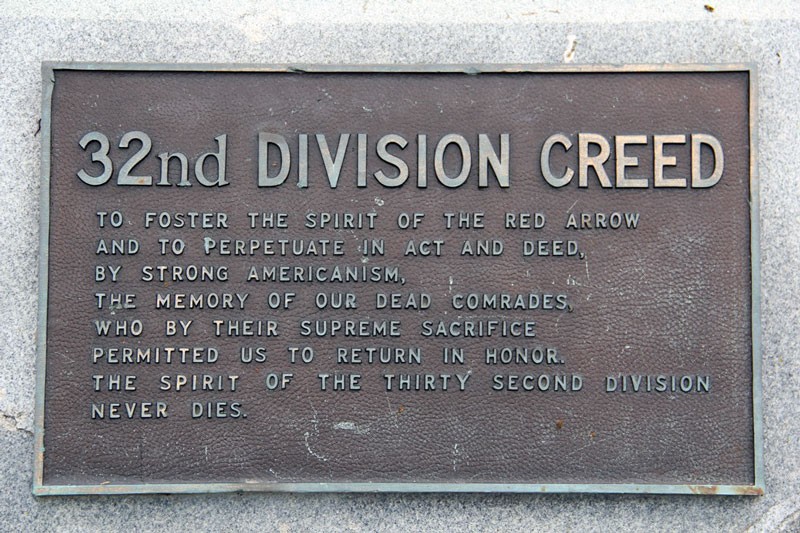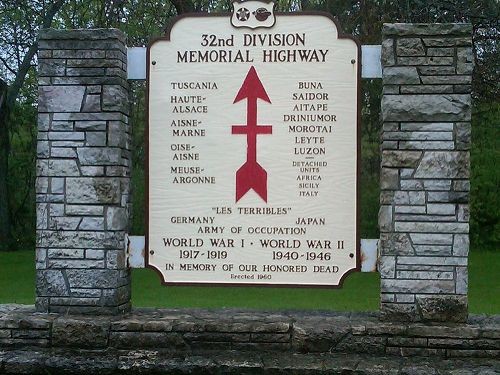Rhodes' Family Home
Introduction
Text-to-speech Audio
Images
The large blue dot is where the SS Tuscania was sunk. Screenshotted from the Smithsonian Magazine website.

A German blockade map from 1918 detailing the German submarine blockade. The light blue highlights show the areas marked as war zones by the Germans.

Plaque stating the Creed of the Red Arrow Division at the Red Arrow Park Memorial in Milwaukee

The distinct arm patch of the 'Red Arrow' division

A memorial highway marker dedicated to the 32nd Infantry Division on Douglas Avenue in Racine, Wisconsin

Backstory and Context
Text-to-speech Audio
Aaron W. Rhodes was barely an adult when he enlisted in the Army National Guard in May of 1917. Having lied on his draft registration, he left his home at 523 College Avenue, soon to be renamed 511 W. College Avenue, in Waukesha just shy of his eighteenth birthday. A member of the 107th Supply Train, he was assigned to the 32nd Division of the Army National Guard. The Division would begin their training at Camp MacArthur in Waco, Texas. However, they would be unable to finish their training before they were deployed. Unfortunately for Rhodes, he would experience the worst the war had to offer before he ever even joined his division in France to finish training.
Along with other miscellaneous members of the 32nd Infantry, Rhodes boarded the S.S. Tuscania, a luxury cruise liner that had been converted to a military transport ship. And on January 27, 1918, the ship departed from Hoboken, New Jersey. The Tuscania entered the so called ‘Danger Zone’, the German war zone surrounding the British Isles, on February 4, 1918. It would be the next night that they would enter the crosshairs of UB77. Spotting the British ship, Kaptain Wilhelm Meyer gave the order to fire two torpedoes at the convoy of fourteen transport vessels and eight British destroyers. Only one of the torpedoes would find its target, recording UB77’s only successful sinking of an enemy ship in its roughly year long service.
Private Rhodes would survive the sinking of the Tuscania, and go with his unit from Islay, Scotland, where a mass amount of the Tuscania survivors had been shuttled to from the crash. By February 15, the men of the 32nd Division had reached England, leaving for France a few short days later. Beginning as a replacement unit, the Division would go without official orders until May of 1918. As summer rolled around, the men were instructed that they were to join the 40th French Corps on the front lines in Alsace, making the members of the 32nd Division the first American soldiers to step foot on German soil during the war.
Over the next few months, the ‘Les Terribles’, so nicknamed by the French for their determined fighting style, would help push the front lines further into Germany. Moving from Alsace, the unit briefly fought in Aisne-Marne, Oise-Aisne, and Meuse-Argonne. It was their ability to pierce through every enemy line they faced that earned the 32nd Division their famed ‘Red Arrow’ moniker.
After a brief stint occupying the Rhine, the men of the 32nd Division were relieved from duty in April of 1919. By May 1, 1919, a majority of the Division’s soldiers had departed Europe, and were bound for home. Corporal Rhodes and a majority of the 107th Supply Train reached Camp Morrison in Newport News, Virginia, aboard the battleship U.S.S Virginia on May 21. Upon their return to Wisconsin, the members of the 32nd Division were greeted with Red Arrow day. June 6, 1919, was set aside to honor the heroic men of the namesake division, and involved a parade, a public welcome to Milwaukee, and an evening ball.
Upon returning home to Waukesha, Rhodes moved back into the family home at 511 W. College Avenue, with his father, Dell, mother, Mary Elanor, and little brother, Harley. Spending a small stint as a machinist at the Waukesha Pure Foods Co., Rhodes worked in the Jiffy Jell Factory. When the factory closed down in 1921, Rhodes and his new wife, Ida, moved to Rockford, Illinois. For the next two years, they would both work at Keeling Drug Company. However, Corporal Rhodes would pass away on March 23, 1923.
While little is known of the man that was Corporal Aaron W. Rhodes, his legacy as a member of the famed ‘Red Arrow’ Division will live on forever. A legendary tale of American patriots who help the people of Wisconsin remember the importance of World War I, and the sacrifice their fellow man made to preserve the American Dream.
Cite This Entry
Sophie Furman. "Rhodes' Family Home." Clio: Your Guide to History. March 6, 2020. Accessed April 22, 2025. https://theclio.com/entry/96027
Sources
The 32D ‘Red Arrow’ Veteran Association. The 32D ‘Red Arrow’ Division in World War I: From ‘The Iron Jaw Division’ to ‘Les Terribles’. http://www.32nd-division.org/history/ww1/32-ww1.html. (Last modified April 17, 2019).
1921 Rockford City Directory. Digital Scan. Ancestry Library, U.S. City Directories 1822-1995. Scanned Manuscript. (Accessed February 25, 2020).
1921 Waukesha City Directory. Digital Scan. Ancestry Library, U.S. City Directories 1822-1995. Scanned manuscript. (Accessed February 25, 2020).
1922 Rockford City Directory. Digital Scan. Ancestry Library, U.S. City Directories 1822-1995. Scanned Manuscript. (Accessed February 25, 2020).
Carl Flemming , Cartographer. Die Schiffsversenkungen unserer U-Boote: nach Lage und Zahl dargestellt auf Grund amtlichen Materials mit Seeschlachten, Sperrgebieten, Landfronten, Land-Gewinn und -Verlust. [Berlin und Glogau: Carl Flemming AG, 1918] Map. https://www.loc.gov/item/2016432165/. (Accessed March 1, 2020).
Family Search. Aaron Rhodes: United States Census, 1920. https://www.familysearch.org/ark:/61903/1:1:MF2D-PJ8. (Accessed February 23, 2020).
Find a Grave. Aaron Walker Rhodes (1898-1923). https://www.findagrave.com/memorial/84493154/aaron-walker-rhodes. (Accessed February 23, 2020).
Guðmundur Helgason. “UB 77”. https://uboat.net/wwi/boats/?boat=UB+77. (Accessed March 1, 2020).
Hamon, Caitlin. SS Tuscania Sinking by U-boat in 1918 Kills 200 Americans. United States Foundation for the Commemoration of the World Wars, 2013-2020. Pritzker Military Museum and Library. https://www.worldwar1centennial.org/index.php/communicate/press-media/wwi-centennial-news/3988-ss-tuscania-sinking-by-u-boat-in-1918-kills-200-americans.html. (Accessed March 2, 2020).
Office of the Adjunct General. Composition of National Guard Divisions and Disposition of Former National Guard Units. Pamphlet. Washington: Government Printing Office. U.S. Army Center of Military History. PDF, https://history.army.mil/curriculum/wwi/docs/AdditionalResources/Comp_of_Natl_Guard_Divisions_and_Disposition_of_Former_Natl_Guard_Units_1916.pdf. (Accessed March 3, 2020).
Passenger List of Organizations and Casuals. Digital scan of original. Hoboken: United States Army Transportation Service. Ancestry Library, U.S. Army Transportation Service. Passenger List. (Accessed February 25, 2020).
Passenger List of Organizations and Casuals. Digital scan of original. United States Army Transportation Service. Ancestry Library, U.S. Army Transportation Service. Passenger List. (Accessed February 25, 2020).
Portage Register=Democrat. “Milwaukee is Soldiers’ Host”. Digital scan of original. Portage: Portage Daily Register, June 6, 1919. Newspapers.com. https://newscomwc.newspapers.com/image/610979762/?terms=red%2Barrow%2Bday&pqsid=2nU9waGcMnvmGd_lDb4tlA:313000:1825674884. (Accessed March 5, 2020).
Smithsonian Magazine. “This Map Shows the Full Extent of Devastation Wrought by U-Boats in World War I”. https://www.smithsonianmag.com/history/map-shows-full-extent-devastation-wrought-uboats-world-war-i-180955191/. (Accessed March 1, 2020).
“Waukesha County Military Service Record of Aaron W. Rhodes”. Waukesha County Historical Society and Museum, World War I Military Registration Cards. Hard Copy Original. (Accessed February 20, 2020).
https://www.smithsonianmag.com/history/map-shows-full-extent-devastation-wrought-uboats-world-war-i-180955191/
The Library of Congress (https://www.loc.gov/resource/g5701s.ct007681/?r=-0.036,0.038,0.906,0.429,0)
https://city.milwaukee.gov/cityclerk/hpc/War-The City of Milwaukee (Memorials-of-Milwaukee/Abraham-Lincoln-Memorial0Copy.htm#.XmJ5IqhKhPY)
https://www.usarmypatches.com/Infantry.htm
https://www.tracesofwar.com/sights/69714/Sign-Remembrance-Road-32nd-Red-Arrow-Division.htm

